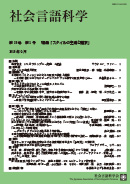Volume 16, Issue 1
Displaying 1-12 of 12 articles from this issue
- |<
- <
- 1
- >
- >|
-
Article type: Article
2013 Volume 16 Issue 1 Pages 1-5
Published: September 30, 2013
Released on J-STAGE: May 02, 2017
Download PDF (596K) -
Article type: Article
2013 Volume 16 Issue 1 Pages 6-21
Published: September 30, 2013
Released on J-STAGE: May 02, 2017
Download PDF (2226K) -
Article type: Article
2013 Volume 16 Issue 1 Pages 22-38
Published: September 30, 2013
Released on J-STAGE: May 02, 2017
Download PDF (2149K) -
Article type: Article
2013 Volume 16 Issue 1 Pages 39-48
Published: September 30, 2013
Released on J-STAGE: May 02, 2017
Download PDF (1358K) -
Article type: Article
2013 Volume 16 Issue 1 Pages 49-64
Published: September 30, 2013
Released on J-STAGE: May 02, 2017
Download PDF (1760K) -
Article type: Article
2013 Volume 16 Issue 1 Pages 65-79
Published: September 30, 2013
Released on J-STAGE: May 02, 2017
Download PDF (1692K) -
Article type: Article
2013 Volume 16 Issue 1 Pages 80-95
Published: September 30, 2013
Released on J-STAGE: May 02, 2017
Download PDF (2113K) -
Article type: Article
2013 Volume 16 Issue 1 Pages 96-108
Published: September 30, 2013
Released on J-STAGE: May 02, 2017
Download PDF (1654K) -
Article type: Article
2013 Volume 16 Issue 1 Pages 109-126
Published: September 30, 2013
Released on J-STAGE: May 02, 2017
Download PDF (2245K) -
Article type: Article
2013 Volume 16 Issue 1 Pages 127-138
Published: September 30, 2013
Released on J-STAGE: May 02, 2017
Download PDF (1648K) -
Article type: Article
2013 Volume 16 Issue 1 Pages 139-159
Published: September 30, 2013
Released on J-STAGE: May 02, 2017
Download PDF (11369K) -
Article type: Article
2013 Volume 16 Issue 1 Pages 160-165
Published: September 30, 2013
Released on J-STAGE: May 02, 2017
Download PDF (782K)
- |<
- <
- 1
- >
- >|
